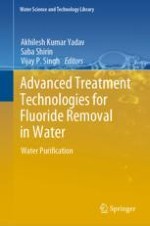2023 | OriginalPaper | Buchkapitel
4. Fluoride Removal from Aqueous Solution Using Iron-Based Materials: Preparation, Characterization, and Applications
verfasst von : Divya Patel, Mridu Kulwant, Saba Shirin, Ramita Varshney, Govind Pandey, Akhilesh Kumar Yadav
Erschienen in: Advanced Treatment Technologies for Fluoride Removal in Water
Verlag: Springer Nature Switzerland
Aktivieren Sie unsere intelligente Suche, um passende Fachinhalte oder Patente zu finden.
Wählen Sie Textabschnitte aus um mit Künstlicher Intelligenz passenden Patente zu finden. powered by
Markieren Sie Textabschnitte, um KI-gestützt weitere passende Inhalte zu finden. powered by
